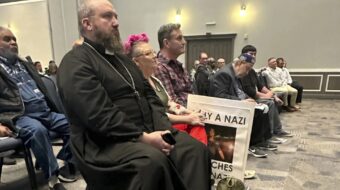CHICAGO — Two “living legends” of the civil rights movement, Diane Nash and the Rev. C. T. Vivian, keynoted “Remembering the Movement,” a Black History Month program, livestreamed from the Harold Washington Wing of the DuSable Museum.
Nash, a student of the Rev. James Lawson , spearheaded the 1960 Nashville Movement that challenged segregated public accommodations, including lunch counters. During this early struggle, Nash was known for innovating a key tactic of the civil rights movement: protesters should not pay bail after their arrests because the activists would be contributing to an unjust and immoral system.
“I spent 10 days in jail because of you,” said museum CEO and civil rights activist Dr. Carol Adams, smiling, in her introduction of Nash.
Chicago was the scene of a major civil rights protest in 1966 to end racist housing segregation. It was also a site of lesser-known struggles, like integrating the building trades unions, construction industry and its contractors. Vivian had worked with local fighters for equality on construction integration during the 1960s and 70s.
Nash helped to found the Student Nonviolent Coordinating Committee, and was a key strategist for the Southern Christian Leadership Conference’s Selma Right-to-Vote Movement.
Nash learned about nonviolent direct action from Lawson, a student of Mohandas Gandhi who went to India to learn about the nonviolent movement to overthrow British colonialism.
“Voting and holding public officials accountable are important,” Nash said, “but it is not enough.” It takes action on the issues, she said.
“Nonviolent resistance is the method most likely to succeed in the 21st century. Few can match Gandhi’s social invention,” she said and referred to the successful nonviolent tactics of the Egyptian revolution. (Reportedly, some of the Egyptian young people used the experience of the U.S. civil rights movement for their own struggles.)
“According to Gandhi there were three levels of resistance to oppression,” she said. The first and best level is using nonviolence, the second, a less favorable method, is to use violence, and the third and worst is to tolerate oppression, she said.
Nash referred to the “difference of opinion” that developed in the civil rights movement between “by any means necessary” vs. nonviolent direct action and campaign. With respect to Malcolm X and others of that era that advocated retaliation for any violent racist attack, Nash stood firmly in the nonviolent camp as the most effective “method to achieve social change.”
The Rev. C.T. Vivian echoed that support for the nonviolent direct action method. Vivian and Nash first met each other in Nashville in 1959, when Vivian went there to learn from Lawson about the strategies behind Gandhi’s “social invention.” Vivian first got involved in the civil rights struggle in 1947 to end segregated lunch counters in Peoria, Ill.
“I don’t say nonviolent by itself. I say nonviolent direct action. Nonviolence has got to make change, and create a new society,” Vivian said. He added that strategy — a plan — is critical to any movement and individual.
“What made [Frederick Douglass] a genius, and Martin, a genius was they had a strategy,” he said.
On the state of Black America today, both Nash and Vivian zeroed in on education, especially guaranteeing every African American child get a college education.
Vivian also urged another big challenge for Black America: re-elect Barack Obama president in 2012. “We have to keep this man, even if we [Black voters] weren’t with him until after Iowa.”
Nash raised a unique idea about economic democracy. “The [G-8] gets together and makes decisions about the economy. They aren’t making these decisions with your interests in mind. There should be economic summits in every neighborhood so citizens can decide which way we want to go,” she said.
The struggle for a better world and life for all is never-ending, they concluded, and each generation has to keep their marching shoes on.
Photo: Moderator Pam Jones of CBS Chicago, left, starts the conversation with the Rev. C.T. Vivian, center, and Diane Nash. (John Bachtell/PW)












Comments